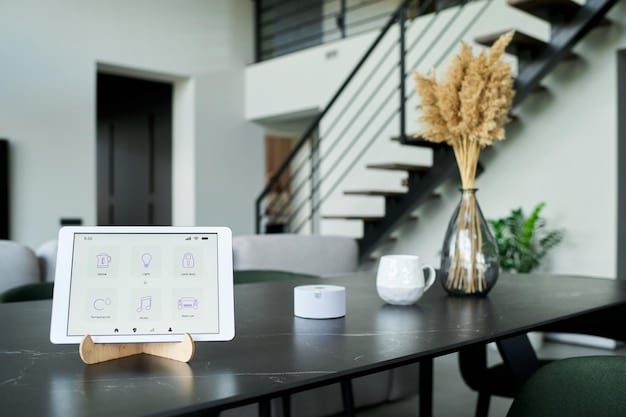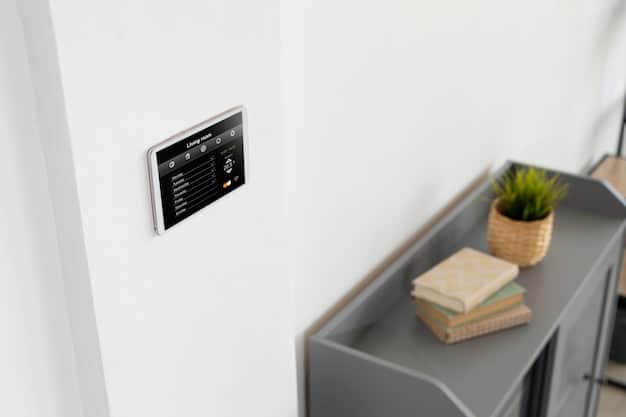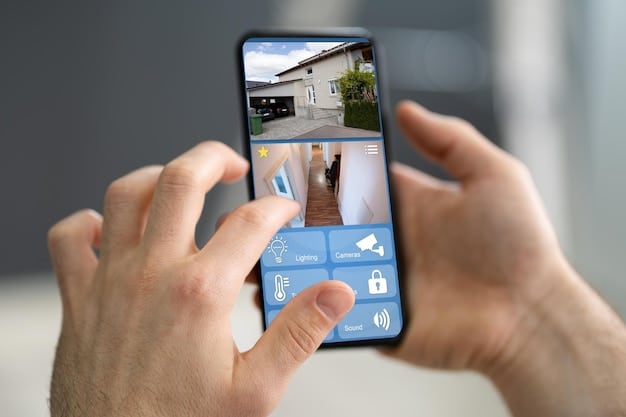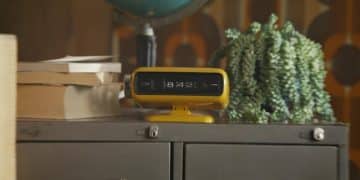Smart Home Sensors: Monitor Air, Leaks & More for Home Automation

Smart home sensors offer convenient and effective means to monitor air quality, detect water leaks, and enhance overall home automation for improved safety and comfort.
Smart home sensors: Monitoring air quality, water leaks, and more are rapidly changing how we interact with our homes. These devices provide real-time data and automated responses, making our living spaces safer, more efficient, and more comfortable.
Understanding smart home sensors
Smart home sensors are devices designed to detect and measure various environmental parameters in your home. They work by collecting data and transmitting it to a central hub or directly to your smartphone, allowing you to monitor conditions remotely and receive alerts when something is amiss.
These sensors are becoming increasingly sophisticated, with features like machine learning and artificial intelligence enhancing their accuracy and predictive capabilities. By using smart home sensors, you can gain valuable insights into your home’s environment and take proactive steps to address potential issues.
Types of Smart Home Sensors
The range of smart home sensors available today is vast, each designed for a specific purpose. Here are some of the most common types:
- Air quality sensors: These devices monitor the levels of pollutants such as carbon monoxide, particulate matter, and volatile organic compounds (VOCs) in your home.
- Water leak sensors: Placed near potential leak sources like washing machines and water heaters, these sensors detect moisture and alert you to prevent water damage.
- Temperature and humidity sensors: These sensors help you maintain optimal indoor conditions, which can improve comfort and reduce energy consumption.
- Motion sensors: Often used for security, motion sensors detect movement and can trigger alarms or activate lighting.
The applications of these sensors extend beyond simple monitoring. They can be integrated into automated systems that respond to changes in the environment, such as adjusting the thermostat based on temperature readings or shutting off the water supply when a leak is detected. With the right combination of sensors and automation, you can create a truly smart home that adapts to your needs and protects your property.

Monitoring air quality with smart sensors
Ensuring good indoor air quality is more important than ever, as we spend a significant portion of our lives indoors. Smart home sensors designed for air quality monitoring can help you identify and address potential pollutants, creating a healthier living environment.
These sensors measure a variety of airborne contaminants, providing valuable data that can inform your decisions about ventilation, air purification, and other strategies to improve air quality.
Key Pollutants Monitored
Air quality sensors can detect a wide range of pollutants, including:
- Carbon Monoxide (CO): A colorless, odorless gas that can be deadly at high concentrations. CO sensors alert you to dangerous levels, often caused by malfunctioning appliances.
- Particulate Matter (PM): Tiny particles that can irritate the lungs and cause respiratory problems. PM sensors measure PM2.5 and PM10 levels, indicating the presence of dust, pollen, and other pollutants.
- Volatile Organic Compounds (VOCs): Gases emitted from household products like paints, cleaning supplies, and furniture. VOC sensors help you identify sources of indoor pollution and take steps to reduce exposure.
- Radon: A radioactive gas that can seep into homes from the ground. While not all smart sensors detect radon, dedicated radon detectors are available to monitor this potential health hazard.
By monitoring these pollutants, you can take targeted actions to improve your indoor air quality. For example, if your air quality sensor detects high levels of VOCs, you can improve ventilation by opening windows or using an air purifier with a VOC filter. Similarly, if you detect elevated PM levels, you can clean your home more frequently and consider using an air purifier with a HEPA filter.
Smart air quality sensors often come with mobile apps that allow you to track pollution levels over time and receive alerts when certain thresholds are exceeded. This data can help you identify patterns and make informed decisions about how to manage your indoor environment.
Detecting water leaks and preventing damage
Water leaks can cause significant damage to your home, leading to costly repairs and potential health hazards from mold growth. Smart home sensors designed for water leak detection provide an early warning system, allowing you to address leaks before they escalate into major problems.
These sensors are typically placed near potential leak sources and use moisture detection technology to identify leaks and alert you via mobile app or other notification methods.
How Water Leak Sensors Work
Water leak sensors use various technologies to detect moisture, including:
- Conductivity sensors: These sensors measure the electrical conductivity between two points. When water is present, the conductivity increases, triggering an alarm.
- Capacitive sensors: These sensors measure changes in capacitance caused by the presence of water. They are highly sensitive and can detect even small amounts of moisture.
- Optical sensors: These sensors use infrared light to detect water. They are less susceptible to false alarms caused by condensation or humidity.
Most water leak sensors are battery-powered and can be easily installed without professional assistance. They come with features like adjustable sensitivity settings and remote monitoring capabilities, allowing you to customize their performance and receive alerts even when you are away from home.
Some advanced water leak detection systems can even shut off the water supply automatically when a leak is detected, minimizing damage and preventing further water loss. These systems typically consist of multiple sensors placed throughout the home and a central control panel that communicates with a motorized shut-off valve on the main water line.
Enhancing home security with smart sensors
Smart home sensors play a crucial role in enhancing home security, providing an extra layer of protection against intrusion and other threats. These sensors can detect unauthorized entry, monitor activity within your home, and alert you and the authorities in the event of an emergency.
From motion sensors to door and window sensors, there are a variety of devices available to help you secure your home.
Types of Security Sensors
Common security sensors include:
- Motion sensors: Detect movement inside or outside your home, triggering alarms or activating security cameras.
- Door and window sensors: Alert you when doors or windows are opened or closed, indicating a potential break-in.
- Glass break sensors: Detect the sound of breaking glass, providing an additional layer of security for windows and glass doors.
- Environmental sensors: Monitor for smoke, fire, and carbon monoxide, providing early warning in the event of a safety hazard.
These sensors can be integrated into comprehensive security systems that include features like professional monitoring, remote access, and mobile alerts. When an alarm is triggered, the system can automatically notify the monitoring center, which can dispatch emergency services if needed. You can also receive notifications on your smartphone, allowing you to monitor your home remotely and take action if necessary.
Smart security sensors can also be combined with other smart home devices to create automated security scenarios. For example, you can set up your system to automatically lock the doors, turn on the lights, and activate the security cameras when you leave home.

Smart sensors for energy efficiency
In addition to enhancing safety and security, smart home sensors can also help you improve energy efficiency and reduce your utility bills. These sensors monitor energy consumption, detect inefficiencies, and automate energy-saving measures.
By tracking your energy usage patterns and identifying areas where you can save energy, you can make informed decisions about how to optimize your home’s energy performance.
Using Sensors to Save Energy
Energy-saving sensors include:
- Smart thermostats: Learn your temperature preferences and automatically adjust the thermostat to save energy when you are away or asleep.
- occupancy sensors: Turn off lights and appliances in unoccupied rooms, preventing energy waste.
- Energy monitoring sensors: Track the energy consumption of individual appliances and devices, allowing you to identify energy hogs and make adjustments.
Smart thermostats are one of the most popular energy-saving smart home devices. These thermostats use sensors to detect your presence and automatically adjust the temperature based on your schedule and preferences. Some models also offer features like geofencing, which uses your smartphone’s location to determine when you are home and adjust the temperature accordingly.
Occupancy sensors are another effective way to save energy. These sensors detect when a room is unoccupied and automatically turn off the lights and other devices. They are particularly useful in areas like hallways, bathrooms, and closets, where lights are often left on accidentally.
Integrating smart sensors into your home automation system
To truly unlock the potential of smart home sensors, it’s important to integrate them into a comprehensive home automation system. This involves connecting your sensors to a central hub or platform that allows them to communicate with each other and with other smart home devices.
By integrating your sensors, you can create automated scenarios that respond to changes in the environment and simplify your daily routines.
Setting Up a Smart Home Ecosystem
Key steps in creating a smart home ecosystem include:
- Choosing a hub or platform: Select a central hub or platform that is compatible with your sensors and other smart home devices.
- Connecting your sensors: Follow the manufacturer’s instructions to connect your sensors to the hub or platform.
- Creating automated scenarios: Use the hub or platform’s automation tools to create scenarios that respond to changes in sensor data.
There are a variety of smart home hubs and platforms available, each with its own strengths and weaknesses. Some popular options include Amazon Alexa, Google Home, Apple HomeKit, and Samsung SmartThings. It’s important to choose a platform that is compatible with the sensors and devices you want to use and that meets your specific needs and preferences.
Once you have connected your sensors to the hub, you can begin creating automated scenarios. For example, you can set up your system to automatically turn on the lights when a motion sensor detects movement in a room, or to send you an alert if a water leak sensor detects moisture near your washing machine. The possibilities are endless, and you can customize your system to meet your unique needs and preferences.
By integrating your smart home sensors into a comprehensive home automation system, you can create a truly smart and responsive home that adapts to your needs and protects your property.
| Key Point | Brief Description |
|---|---|
| 💨 Air Quality Sensors | Monitor pollutants like CO, PM, and VOCs, improving indoor health. |
| 💧 Water Leak Sensors | Detect moisture to prevent water damage from leaks, offering early alerts. |
| 🛡️ Security Sensors | Enhance security with motion, door/window, and glass break sensors. |
| 💡 Energy Efficiency | Reduce energy waste using smart thermostats and occupancy sensors. |
FAQ
Smart home sensors enhance safety by detecting leaks and pollutants, improve energy efficiency through automated controls, and increase convenience with remote monitoring and customizable scenarios.
Most smart home sensors are easy to install. They typically involve placing the sensor in a strategic location, connecting it to your home Wi-Fi, and configuring settings via a mobile app.
Yes, most smart home sensors can be integrated with other smart devices through platforms like Amazon Alexa, Google Home, or Apple HomeKit, enabling coordinated automated actions.
Smart home sensors typically require minimal maintenance. Regularly check battery levels and sensor placement, and clean sensors periodically to ensure accurate readings and optimal performance.
Smart home sensors can be vulnerable, so ensure your network is secure. Choose reputable brands and update firmware regularly. Use complex passwords and enable two-factor authentication for added security.
Conclusion
Smart home sensors: Monitoring air quality, water leaks, and more are essential for creating a safe, efficient, and comfortable living environment. By understanding the different types of sensors available and how to integrate them into your home automation system, you can take control of your home’s environment and protect your property from potential threats.





